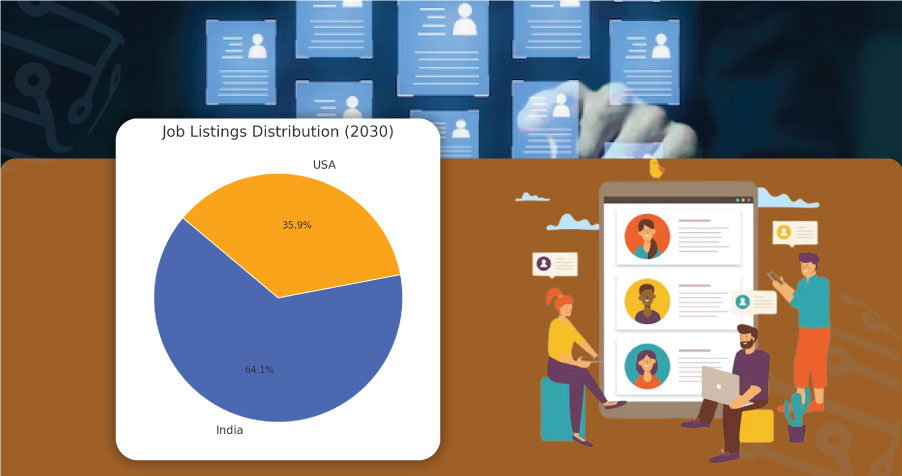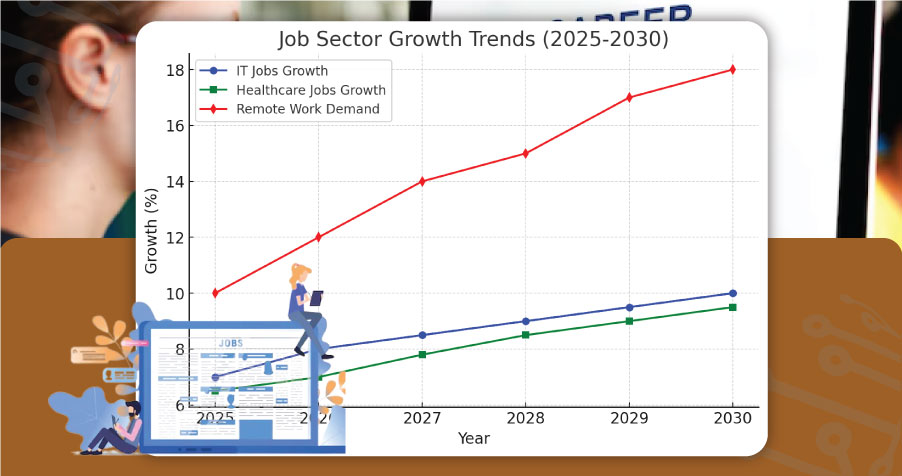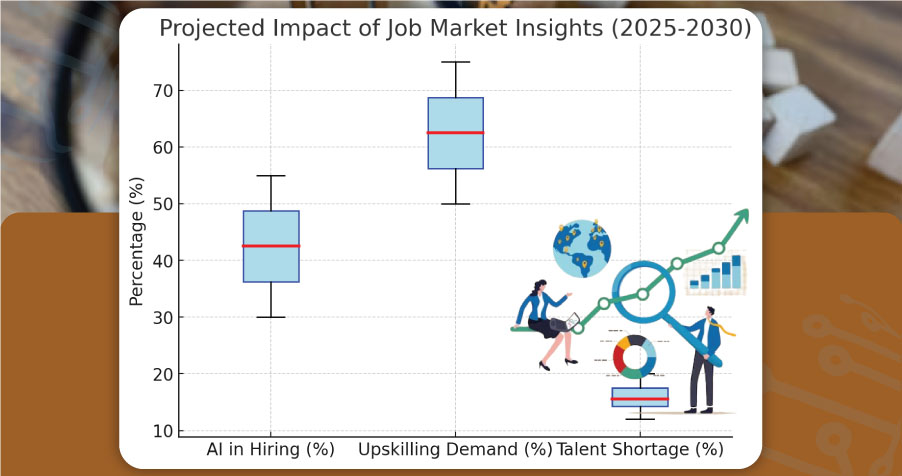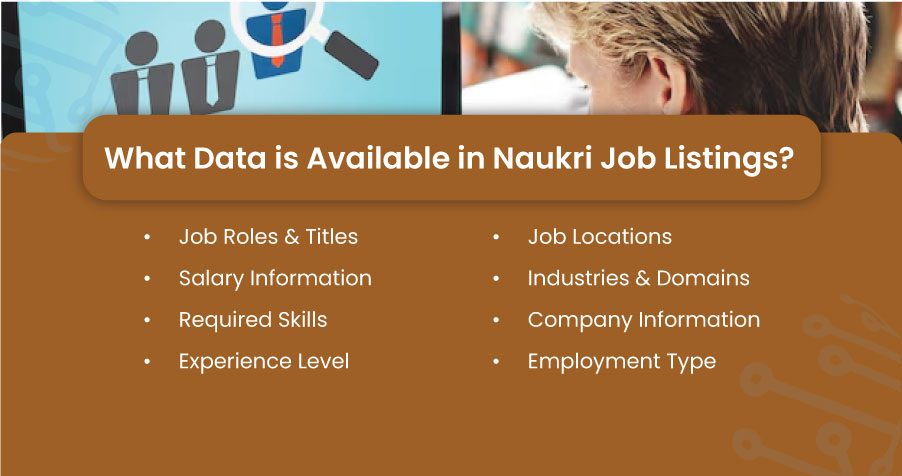
Introduction
In the digital age, job market analytics play a crucial role in understanding employment trends, workforce demands, and industry growth. One of the most valuable resources for such analysis is the Naukri Job Listings Dataset, which provides extensive data on job postings, hiring patterns, and recruitment preferences in India and the USA.
By leveraging HR and recruitment datasets, businesses can optimize their hiring strategies, while job seekers can identify high-demand skills and career opportunities. The ability to extract job application trends helps companies make data-driven decisions, ensuring a competitive edge in the evolving job market.
The following sections explore the significance of analyzing Naukri job market insights, methods for data extraction, and statistical projections from 2025 to 2030 to illustrate the potential impact of HR analytics on recruitment strategies.
Brief Overview of Naukri Job Listings Datasets

The Naukri Job Listings Dataset is a rich repository of employment data, featuring job roles, industries, salaries, required skills, and employer details. By utilizing HR and recruitment data scraping, businesses can extract valuable insights on hiring trends and workforce demand.
Key Features of Naukri Job Listings Dataset:
- Industry-Specific Job Listings: Covers IT, healthcare, finance, marketing, and more.
- Skill Demand Analysis: Identifies trending skills and emerging job roles.
- Salary Benchmarking: Helps professionals and businesses understand competitive salaries.
- Application Patterns: Reveals job seeker behaviors and preferred locations.
- Recruiter Preferences: Highlights the most sought-after qualifications and experience levels.
Projected Naukri Job Market Statistics (2025-2030):
| Year | Job Listings (India) | Job Listings (USA) | Average Salary Growth |
|---|---|---|---|
| 2025 | 12M | 8M | 5.2% |
| 2026 | 13.5M | 8.5M | 5.5% |
| 2027 | 15M | 9M | 5.8% |
| 2028 | 16.8M | 9.8M | 6.1% |
| 2029 | 18.5M | 10.5M | 6.4% |
| 2030 | 20M | 11.2M | 6.7% |
Importance of Analyzing Hiring Trends in India & USA

Understanding hiring trends is essential for businesses, recruiters, and job seekers to stay competitive. The analysis of Naukri job listings datasets allows stakeholders to identify market fluctuations, skills in demand, and emerging job sectors.
Benefits of Hiring Trend Analysis:
- For Businesses: Optimizes recruitment strategies by predicting future talent needs.
- For Job Seekers: Guides career choices by highlighting high-growth industries.
- For Economists & Policymakers: Helps in understanding workforce shifts and employment rates.
Projected Hiring Trends (2025-2030):
| Year | IT Jobs Growth | Healthcare Jobs Growth | Remote Work Demand |
|---|---|---|---|
| 2025 | 7% | 6.5% | 10% |
| 2026 | 8% | 7% | 12% |
| 2027 | 8.5% | 7.8% | 14% |
| 2028 | 9% | 8.5% | 15% |
| 2029 | 9.5% | 9% | 17% |
| 2030 | 10% | 9.5% | 18% |
How Job Market Insights Help Businesses & Job Seekers?

Analyzing job market insights enables businesses to refine their hiring strategies and empowers job seekers with informed career decisions. The extraction of job application trends analytics enhances visibility into industry demands.
Impact of Job Market Insights:
-
For Businesses:
- Align recruitment efforts with industry demands.
- Improve workforce planning and employee retention.
- Reduce hiring costs through data-driven decisions.
-
For Job Seekers:
- Identify lucrative job sectors.
- Enhance skillsets based on market trends.
- Improve job search efficiency with targeted applications.
Projected Impact of Job Market Insights (2025-2030):
| Year | AI in Hiring (%) | Upskilling Demand (%) | Talent Shortage (%) |
|---|---|---|---|
| 2025 | 30% | 50% | 20% |
| 2026 | 35% | 55% | 18% |
| 2027 | 40% | 60% | 16% |
| 2028 | 45% | 65% | 15% |
| 2029 | 50% | 70% | 14% |
| 2030 | 55% | 75% | 12% |
Understanding Naukri Job Listings Data

Naukri is one of India's leading job portals, hosting a vast database of job listings across multiple industries. Naukri job listings data provides valuable insights into job market trends, hiring practices, and skill demand. Understanding and leveraging this data can help businesses, recruiters, and job seekers make informed decisions.
What Data is Available in Naukri Job Listings?
Naukri job listings contain diverse datasets that offer insights into the job market. Some of the key data points include:
- Job Roles & Titles: Listings include various job roles such as software engineer, data analyst, marketing executive, and project manager.
- Job Locations: Employers specify job locations, covering metropolitan cities like Mumbai, Bangalore, Delhi, Chennai, and international locations.
- Salary Information: Some job listings disclose salary ranges, helping candidates gauge compensation trends.
- Industries & Domains: Naukri covers diverse industries, including IT, healthcare, finance, manufacturing, and retail.
- Required Skills: Each listing highlights essential skills such as Python, Java, digital marketing, machine learning, and cloud computing.
- Company Information: Details include employer names, company size, and job posting history.
- Experience Level: Jobs are categorized into entry-level, mid-level, and senior roles based on required experience.
- Employment Type: Full-time, part-time, contract, internship, and freelance opportunities.
How is Naukri Job Data Structured and Collected?
Naukri organizes job listings in a structured format with well-defined metadata, making it easier to extract insights. The data is structured as follows:
1. Job Listing Pages: Each job listing includes a detailed job description, company information, and application instructions.
2. Categorization & Tags: Listings are tagged with keywords like industry type, required skills, and experience level.
3. Filters & Search Queries: Users can filter job listings based on location, salary, skills, and experience.
Web Scraping Naukri Job Listings Data
Web scraping allows businesses to extract Naukri hiring trends in the USA and India efficiently. By using Web Scraping Services, companies can gather real-time job market insights, track employer demand, and analyze salary trends.
Latest Trends (2025-2030)
- AI-powered Recruitment: Increasing automation in job recommendations and resume screening.
- Remote Work Expansion: Growing demand for hybrid and remote job opportunities.
- Skill-based Hiring: Employers prioritizing skill sets over traditional degrees.
- Data-driven Recruitment: Companies leveraging analytics to refine hiring strategies.
Web Scraping Solutions for Naukri Job Data
- Web Scraping API Services: Automating job listing extraction using APIs.
- Mobile App Scraping Services: Extracting job data from mobile apps for real-time insights.
- Extract API for Naukri Job Postings: Efficient data retrieval for recruitment analytics.
Hiring Trends in India
Overview of India's Job Market
India's job market is evolving rapidly, driven by technological advancements, startup growth, and government initiatives like Digital India. The demand for digital skills continues to rise, impacting hiring patterns across industries.
High-Demand Industries & Emerging Job Roles
| Industry | Emerging Job Roles |
|---|---|
| IT & Software Development | AI engineers, cybersecurity specialists, full-stack developers |
| Healthcare & Biotechnology | Medical data analysts, healthcare AI specialists |
| E-commerce & Digital Marketing | SEO strategists, e-commerce growth managers |
| Green Energy & Sustainability | Renewable energy engineers, ESG analysts |
Impact of Remote Work and Gig Economy
| Trend | Impact |
|---|---|
| Gig Economy Growth | Increase in freelance and contract-based roles in IT, content creation, and consulting. |
| Hybrid Work Models | Rising demand for remote work technologies and flexible job arrangements. |
Regional Hiring Trends in Metro vs. Tier-2 Cities
| City Type | Hiring Trends |
|---|---|
| Metro Cities (Bangalore, Delhi, Mumbai, Chennai) | High demand for AI, fintech, and data science roles. |
| Tier-2 Cities (Indore, Jaipur, Coimbatore, Lucknow) | Growth in BPO, IT services, and manufacturing sectors due to lower costs and government incentives. |
Projected Growth in India's Job Market (2025-2030)
| Metric | Value |
|---|---|
| Annual Job Additions Required | 7.85 million jobs per year until 2030 |
| Projected Job Market Growth in 2025 |
9% overall growth, with sector-specific increases: - IT: 15% - Retail: 12% - Telecommunications: 11% |
Sector-Specific Hiring Projections for 2025
| Sector | Projected Hiring Growth | Key Drivers |
|---|---|---|
| Information Technology | 15% | Expansion of global capability centers (GCCs) and multi-cloud adoption |
| Retail | 12% | Rising consumer spending in tier-2 and tier-3 cities, resurgence of experiential brick-and-mortar stores |
| Telecommunications | 11% | Advancements in AI, 5G, and IoT technologies |
City-Wise Job Growth Projections for 2025
| City | Projected Job Growth | Contributing Factors |
|---|---|---|
| Bengaluru | 10% | Expansion in IT and technology sectors |
| Coimbatore | 9% | Diversification of hiring across geographies |
| Hyderabad | 8% | Growth in technology and startup ecosystems |
| Chennai | 6% | Industrial growth and infrastructure development |
Workforce Composition and Employment Status
| Employment Category | Percentage of Workforce | Notes |
|---|---|---|
| Self-Employed | 57.3% | Includes 18.3% unpaid workers in household enterprises |
| Casual Labour | 21.8% | Typically involves informal and low-paid jobs |
| Regular Wage/Salaried Workers | 20.9% | Reflects formal employment with regular wages |
Global Capability Centers (GCCs) in India
| Metric | Value |
|---|---|
| Current Market Size (FY2024) | $64.6 billion |
| Projected Market Size (by 2030) | $99-105 billion |
| Current Number of Companies with GCCs | Approximately 1,700 |
| Projected Number of Companies (2030) | 2,100-2,200 |
| Current Employment in GCCs | 1.9 million individuals |
| Projected Employment (2030) | 2.5-2.8 million individuals |
Web Scraping Naukri Job Listings Data
Web scraping allows businesses to extract Naukri hiring trends in the USA and India efficiently. By using Web Scraping Services, companies can gather real-time job market insights, track employer demand, and analyze salary trends.
HR and Recruitment Datasets & Insights
| Service | Description |
|---|---|
| HR and Recruitment Data Scraping | Extract job listings, candidate applications, and hiring trends for strategic decision-making. |
| Extract Naukri Job Listings Dataset USA | Analyzing US job market trends through Naukri. |
| Web Scraping Naukri Job Market Insights India | Capturing hiring trends, salary benchmarks, and industry shifts. |
| Extract Naukri Job Application Trends Analytics | Understanding job seeker behavior and application rates. |
Web Scraping Solutions for Naukri Job Data
| Service | Function |
|---|---|
| Web Scraping API Services | Automating job listing extraction using APIs. |
| Mobile App Scraping Services | Extracting job data from mobile apps for real-time insights. |
| Extract API for Naukri Job Postings | Efficient data retrieval for recruitment analytics. |
Leveraging Naukri job listings data scraping can empower businesses to make informed hiring decisions, monitor market trends, and stay competitive in the dynamic job landscape.
Hiring Trends in the USA
The U.S. job market is undergoing significant transformations, influenced by technological advancements, demographic shifts, and evolving economic landscapes. Below is an analysis of key hiring trends projected for 2025–2030, focusing on major industries, the impact of technology, and a comparison with India's job market.
Key Industries Driving Employment in the USA
The following table highlights the projected employment changes across various U.S. industries from 2022 to 2032:
| Industry Sector | Projected Employment Change (2022–2032) | Annual Growth Rate |
|---|---|---|
| Healthcare and Social Assistance | +2.1 million jobs | 1.6% |
| Professional, Scientific, and Technical Services | +1.0 million jobs | 0.9% |
| Retail Trade | -586,800 jobs | -0.2% |
| Manufacturing | +143,700 jobs | 0.1% |
| Construction | +315,000 jobs | 0.4% |
| Information | +212,000 jobs | 0.7% |
| Transportation and Warehousing | +466,800 jobs | 0.6% |
Source: U.S. Bureau of Labor Statistics, Employment Projections 2022–2032
Role of Tech Jobs, Healthcare, and Finance in Hiring Trends
- Healthcare: Driven by an aging population and increased prevalence of chronic conditions, the healthcare sector is expected to add approximately 2.1 million jobs by 2032, making it the fastest-growing sector.
- Technology: The demand for information technology products and services, including areas like cybersecurity, artificial intelligence, and data analytics, is projected to result in a 12.9% growth in computer and mathematical occupations over the next decade.
- Finance: While specific projections for the finance sector are not detailed in the provided sources, the integration of technologies such as AI and automation is expected to reshape roles within finance, emphasizing the need for tech-savvy professionals.
Role of Tech Jobs, Healthcare, and Finance in Hiring Trends
- Healthcare: Driven by an aging population and increased prevalence of chronic conditions, the healthcare sector is expected to add approximately 2.1 million jobs by 2032, making it the fastest-growing sector.
- Technology: The demand for information technology products and services, including areas like cybersecurity, artificial intelligence, and data analytics, is projected to result in a 12.9% growth in computer and mathematical occupations over the next decade.
- Finance: While specific projections for the finance sector are not detailed in the provided sources, the integration of technologies such as AI and automation is expected to reshape roles within finance, emphasizing the need for tech-savvy professionals.
The Effect of AI and Automation on Job Demand
Artificial intelligence (AI) and automation are poised to significantly influence job demand across various sectors:
- Job Creation and Displacement: Globally, AI is anticipated to create approximately 170 million jobs while displacing 92 million by 2030, resulting in a net gain of 78 million jobs.
Industry Impact
- Manufacturing: Automation is expected to continue reducing the need for low-skilled labor, leading to a slight decline in manufacturing employment.
- Service Industries: Sectors like retail and hospitality may experience job reductions due to AI-driven efficiencies, such as automated customer service and inventory management.
- New Opportunities: Conversely, AI is creating roles in machine learning, robotics, and data analysis, highlighting the importance of upskilling the workforce.
Job Market Comparison: India vs. USA
A comparative analysis of projected job market trends between India and the USA reveals distinct dynamics.
Job Market Comparison: India vs. USA
| Aspect | USA | India |
|---|---|---|
| Population Growth | Slower growth with an aging demographic. | Younger population with a median age of 28.4 years, leading to a growing workforce. |
| Technology Adoption | Rapid integration of AI and automation, leading to shifts in job types and required skills. | Increasing adoption of technology, with a focus on IT services and software development. |
| Sectoral Growth | Significant growth in healthcare and tech sectors; decline in traditional retail and manufacturing. | Expansion in IT services, manufacturing, and a burgeoning startup ecosystem. |
| Employment Challenges | Need for upskilling to meet the demands of emerging tech roles; addressing job displacement due to automation. | Creating sufficient job opportunities for a large, young workforce; bridging the skill gap in rural areas. |
Note: Specific projections for India from 2025 to 2030 are limited; the above insights are based on current trends and available data.
Naukri.com Job Listings and Hiring Trends in the USA
Naukri.com primarily focuses on the Indian job market, and its dataset may not comprehensively represent hiring trends in the USA. For detailed and accurate data on U.S. hiring trends, it is advisable to consult U.S.-based job portals and official labor statistics.
The period from 2025 to 2030 is expected to witness significant shifts in the U.S. job market, driven by technological advancements, demographic changes, and evolving economic priorities. Industries such as healthcare and technology are poised for substantial growth, while sectors like retail may face challenges due to automation and changing consumer behaviors. Understanding these trends is crucial for policymakers, businesses, and the workforce to navigate the future employment landscape effectively.
How Businesses Can Leverage Naukri Job Datasets?

In today’s dynamic job market, HR and Recruitment Datasets play a crucial role in shaping hiring strategies, workforce planning, and skills development. Extracting insights from HR and Recruitment Data Scraping of platforms like Naukri can offer businesses a competitive edge. Below are key ways in which different industries can leverage Naukri job datasets effectively.
1. Recruitment Agencies & HR Tech: Analyzing Demand for Skillsets
Recruitment agencies and HR technology firms can utilize Naukri job listings dataset USA and India to analyze hiring trends across industries. By implementing HR and Recruitment Data Scraping, businesses can:
- Identify the most in-demand skills and tailor recruitment strategies accordingly.
- Track regional hiring trends and optimize talent acquisition strategies for specific locations.
- Leverage machine learning algorithms to predict future talent demand based on job market insights India.
- Enhance applicant tracking systems (ATS) by integrating Naukri job application trends analytics for better candidate recommendations.
2. Enterprises: Workforce Planning Based on Hiring Trends
Large enterprises need to align their workforce with evolving industry demands. Using web scraping Naukri job market insights India, businesses can:
- Analyze job posting patterns to understand which roles are experiencing increased demand.
- Benchmark industry salaries and job requirements to enhance internal workforce planning.
- Identify skill gaps within their teams and develop upskilling initiatives.
- Improve retention strategies by assessing hiring trends within competing organizations.
3. EdTech Platforms: Aligning Courses with Job Market Needs
Educational technology (EdTech) platforms can leverage Extract Naukri job listings dataset USA and India to bridge the gap between academia and industry requirements. By analyzing job market insights, EdTech businesses can:
- Design course curriculums that align with real-time hiring trends.
- Identify emerging technologies and skills that are gaining traction among employers.
- Develop data-driven career guidance tools for students and professionals.
- Create dynamic learning programs based on Naukri job application trends analytics to ensure learners acquire job-relevant competencies.
Harnessing the power of HR and Recruitment Data Scraping enables businesses to make data-driven hiring decisions, improve workforce planning, and enhance learning outcomes. By extracting and analyzing Naukri job datasets, recruitment agencies, enterprises, and EdTech platforms can stay ahead in an ever-evolving job market.
Data-Driven Hiring Strategies

Companies today use data-driven hiring strategies to predict job market trends, analyze competitors’ hiring patterns, and leverage AI for efficient recruitment. Here’s how they do it, with real-world examples:
1. Predicting Future Job Market Trends Using Historical Data
Organizations use historical hiring data to forecast talent demands and skill shortages.
Example:
- Google: By analyzing past hiring trends, Google identified a growing need for AI and machine learning specialists. Anticipating a shortage of skilled professionals, they launched programs like "Google AI Residency" to train and hire top talent before demand exceeded supply.
- Healthcare Industry: During the COVID-19 pandemic, hospitals used historical data on flu outbreaks and patient influx to predict increased demand for nurses and telehealth specialists, allowing them to scale hiring accordingly.
2. Competitor Analysis: Understanding Hiring Patterns in Different Industries
Businesses track their competitors’ hiring trends to refine their own strategies.
Example:
- Amazon vs. Walmart: When Amazon significantly expanded its logistics workforce to meet e-commerce demand, Walmart responded by analyzing Amazon’s job postings and hiring trends. Walmart then increased hiring in distribution centers and introduced better incentives to attract warehouse workers.
- Tesla vs. Rivian: Tesla tracks hiring trends in the electric vehicle (EV) industry. When Rivian began aggressively hiring battery engineers, Tesla adjusted its hiring strategy to secure top talent before competitors could poach them.
3. How AI & Data Analytics Improve Recruitment Efficiency
AI tools enhance the hiring process by automating candidate screening and predicting successful hires.
Example:
- Unilever: Uses AI-powered video interviews that analyze candidates’ tone, facial expressions, and speech patterns to assess suitability for roles. This has reduced hiring time by 70% and increased diversity in their workforce.
- IBM Watson Recruitment: IBM’s AI tool screens thousands of resumes and matches candidates to job descriptions with high accuracy, cutting down the time recruiters spend on initial screenings by 66%.
By integrating historical data, competitor analysis, and AI-powered recruitment, companies like Google, Amazon, Tesla, Unilever, and IBM optimize their hiring strategies, ensuring they stay ahead in a competitive job market.
Conclusion
Data-driven hiring is revolutionizing recruitment by leveraging historical data, competitor analysis, and AI-driven insights. Companies like Google, Amazon, and Unilever use these strategies to predict job trends, refine hiring approaches, and streamline recruitment.
ArcTechnolabs empowers businesses by providing access to Naukri Job Listings Datasets, helping them analyze hiring trends, salary benchmarks, and in-demand skills. With our data solutions, companies can make informed hiring decisions and stay ahead of the competition.
Get Naukri hiring trends data today! Contact ArcTechnolabs to unlock valuable insights and optimize your recruitment strategy.






